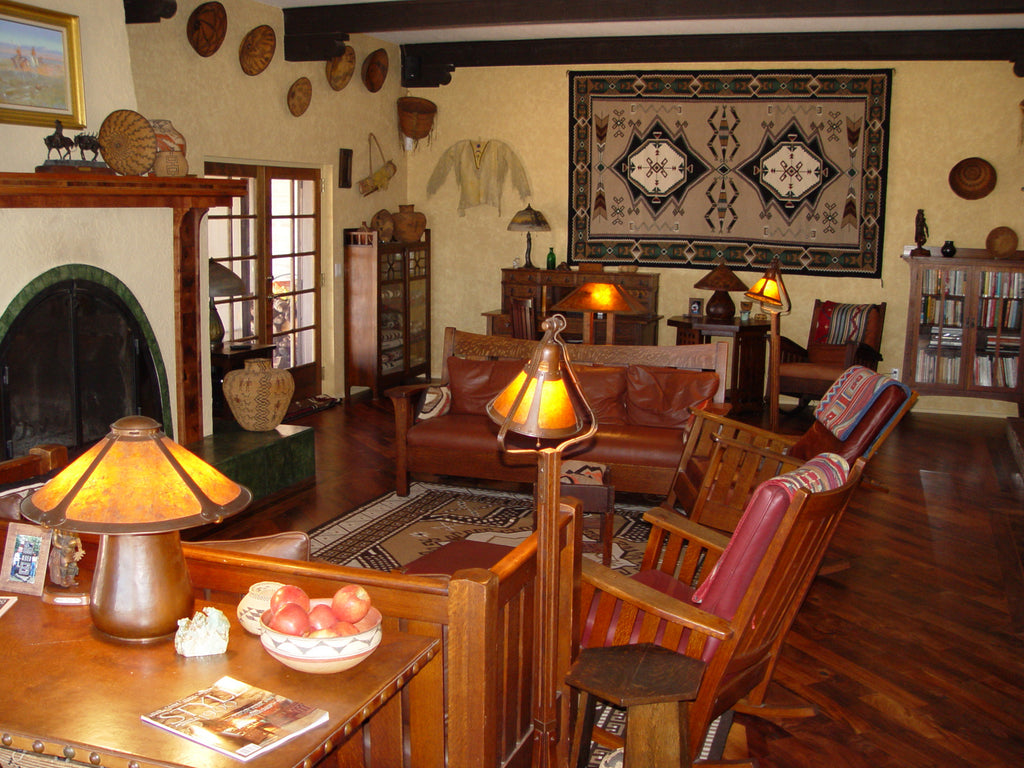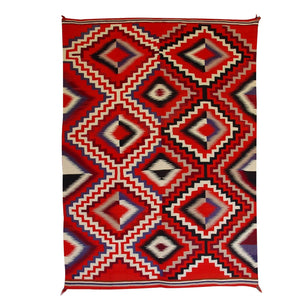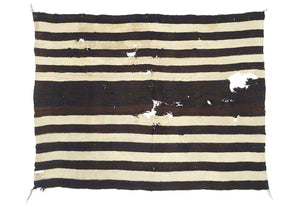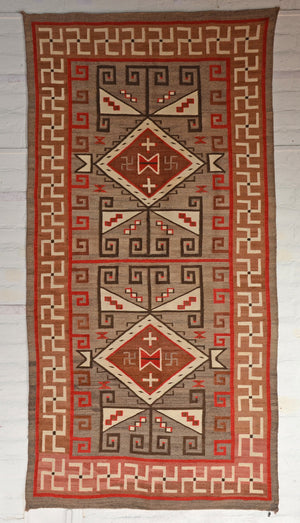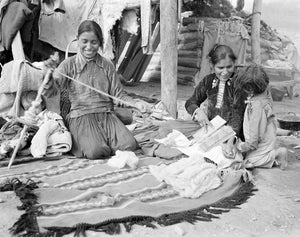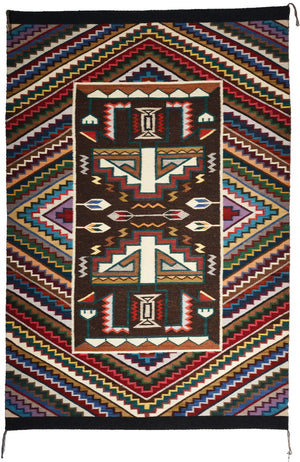The weaving of wearing blankets is part of the Navajo (Diné) creation story, present in Navajo culture from the beginning. Spider Woman, who wove the web of the universe, taught the Navajo people to weave. She is present in their lives today, residing atop Spider Rock in Canyon de Chelly.

An Early Classic First Phase Chief’s Blanket, Diné (Navajo), circa 1830, also known as the Schoch First Phase. The first phase measures 54 inches long by 73 inches wide, as woven. In the collection of the Bernisches Historisches Museum (BHM), Bern, Switzerland, by purchase from Marie Karolina Ruef, Lorenz Alphons Schoch’s widow, 1890. BHM Catalog #1890.410.0027. Cataloged by BHM as a “Sioux trade cloth.” Photograph by Joshua Baer. © 2021 Joshua Baer & Company, Santa Fe. Used by permission. All reproduction rights reserved.
The Navajo philosophy of Sa’ah Naaghai Bik’eh Hozhoo guides life in balance and in harmony with the natural world and the universe. Balance occurs in the physical world with a reverence for the four cardinal directions, the four sacred colors and the four sacred mountains that border Navajo Country.
Balance is the theme of the Beauty Way Chant, part of which reads:
In beauty I walk
With beauty before me I walk
With beauty behind me I walk
With beauty above me I walk
With beauty around me I walk
It has become beauty again
To the south of Navajo Country, or Dinétah, were the Hopi. To the north were the Utes. Navajo wearing blankets were admired by the Hopi and Utes, who bartered with the Navajo for their blankets. Navajo blankets woven longer than wide were called “serapes” by the Spanish. Navajo blankets woven wider than long were called either “chief’s blankets” or “mantas.” The term “chief’s blanket” came into use because chief’s blankets were expensive. Only the high-ranking members of the Utes and the Plains tribes could afford them. According to Joshua Baer, an appraiser of Navajo blankets in Santa Fe, “Anglo-American explorers and military officers began collecting Navajo chief’s blankets during the 1840s. Between 1840 and 1860, the rate of exchange for one chief’s blanket was either 10 buffalo hides, 20 horses, or $50 in gold. In 1850, $10 was one month’s pay for a cavalry officer in the U.S. Army. The $10 gold piece, or ‘eagle,’ contained one-half of one ounce of gold.”

Karl Bodmer (1809-1893), Kiäsax, Piegan Blackfoot Man, 1833, watercolor and graphite on paper. Joslyn Art Museum, Omaha, Nebraska. Gift of the Enron Art Foundation, 1986.49.395. Photograph © Bruce M. White, 2019.
Navajo chief’s blankets were valued by the Ute, the Sioux and the Cheyenne because of their beauty, but also because they were so tightly woven as to be nearly waterproof and could be worn as a coat in the daytime and used as a blanket at night. Examples of early first phase chief’s blankets are scarce today because they were worn aggressively until they were worn out.
Early chief’s blankets featured broad stripes of blue, brown and white handspun Churro yarns. The handspun brown and white yarns were un-dyed. The handspun blue yarns were dyed in the yarn with indigo. Baer explains, “After the introduction of rectangular, target designs during the 1840s, and the subsequent introduction of concentric diamonds during the 1850s, Navajo chief’s blankets with no designs came to be known as ‘first phases.’ Chief’s blankets with rectangular designs came to be known as ‘second phases’ and chief’s blankets with concentric diamonds came to be known as ‘third phases.’” First-phase chief’s with broad brown and white stripes are referred to as man’s style, in contrast to the woman’s style chiefs blankets which have narrow stripes.

An Early Classic First Phase Chief’s Blanket, Diné (Navajo), circa 1830, also known as the Schoch First Phase. The first phase measures 54 inches long by 73 inches wide, as woven. In the collection of the Bernisches Historisches Museum (BHM), Bern, Switzerland, by purchase from Marie Karolina Ruef, Lorenz Alphons Schoch’s widow, 1890. BHM Catalog #1890.410.0027. Cataloged by BHM as a “Sioux trade cloth.” The image has been enhanced to show how the first phase may have looked in original condition. Photograph by Joshua Baer. © 2021 Joshua Baer & Company, Santa Fe. Used by permission. All reproduction rights reserved.
First phase chief’s blankets with brown, white and blue stripes are known as Ute style first phase chief’s blankets. Blankets with thin red stripes between the blue and brown stripes are known as bayeta first phase chief’s blankets because of their use of raveled bayeta yarn. The Navajo weavers were adept at dying their handspun yarn blue with indigo but weren’t able to dye their handspun yarn red with cochineal. Produced in Mexico, cochineal is the dried and pulverized larvae of ladybugs. In the 17th century, cochineal was declared the property of the King of Spain and shipped to Spain where it was used to color woolen cloth in vats.
In response to Spain’s attempts to monopolize cochineal, the British developed a red dye from lac, a scale insect found in Bengal. Red bayeta cloth was woven and piece-dyed in Seville, Spain, and in Manchester, England, then exported in bolts to North America. Bayeta was then shipped from ports in New Orleans and Charleston to St. Louis where it was transported by mule to merchants in Santa Fe, Taos, and the Chama Valley. When bayeta arrived in Navajo Country, Navajo weavers raveled the woven cloth to obtain red yarn to weave into their blankets. Between 1830 and 1860, bayeta was Navajo weavers’ primary source of red yarn. Navajo weavers also used a red knitting yarn from Germany, known as Saxony.

A Classic Bayeta First Phase Chief’s Blanket, Diné (Navajo), ca. 1850. The bayeta first phase measures 57 inches long by 71 inches wide, as woven. Collected, 1851, by Samuel W. Woodhouse (1821-1904), a surgeon and naturalist who accompanied the Topographical Engineer Corps on the Sitgreaves Expedition to explore the Zuni and Colorado Rivers. Inherited by Woodhouse’s son, Samuel W. Woodhouse Jr. (1873-1943). Purchased by the Museum of the American Indian (MAI) from Woodhouse Jr., 1923. Image courtesy of the National Museum of the American Indian (NMAI), Washington, D.C. NMAI Catalog #11/8280.
Baer explains the incorporation of red yarn in second and third phase blankets and subsequent variants: “Second phase chief’s blankets have horizontally banded fields with rectangular foreground designs, usually in the form of either concentric squares, concentric rectangles, or pairs of solid rectangular bars. Ute Style second phases have no thin red stripes between their design elements. Bayeta second phases have thin, horizontal red stripes of raveled bayeta between their design elements.
“Third phase chief’s blankets have horizontally banded fields with diamond-shaped foreground designs. Ute Style third phases have no thin red stripes between their diamonds. Bayeta third phases have thin red stripes of raveled bayeta between their diamonds.
“Navajo chief’s blankets that combine second and third phase designs are called variants. Chief’s blankets with designs appropriated from Navajo dress halves, mantas, poncho serapes or serapes are also called variants.”
An installation of the three phases of Navajo chief’s blankets can be seen at the National Museum of the American Indian in Washington, D.C. The Nelson-Atkins Museum in Kansas City, Missouri, has what Baer considers to be one of two Ute style first phase chief’s blankets in mint condition. The Nelson-Atkins also has as a chief’s blanket variant with a spur pattern in cochineal-dyed bayeta wool, circa 1840.

A Classic Second Phase Chief Blanket, Ute Style, Diné (Navajo), circa 1850. The second phase measures 56 inches long by 75 inches wide, as woven. Collected, 1851, by Samuel W. Woodhouse (1821-1904), a surgeon and naturalist who accompanied the Topographical Engineer Corps on the Sitgreaves Expedition to explore the Zuni and Colorado Rivers. Inherited by Woodhouse’s son, Samuel W. Woodhouse Jr. (1873-1943). Purchased by the Museum of the American Indian (MAI), New York, from Woodhouse Jr., 1923. Image courtesy of the National Museum of the American Indian (NMAI), Washington, D.C. Image courtesy of NMAI. NMAI Catalog #11/8281.
The Nelson-Atkins Museum describes its first phase blanket as “a broad horizontal configuration of contrasting and subtly colored bands…often described as a distillation of the Navajo’s desert plateau and mountain landscape.”
A characteristic of Navajo looms is that they were often set up outdoors where the weavers looked through them at the landscape as they worked.
The widespread trade in chief’s blankets is documented in a watercolor by Karl Bodmer (1809-1893), a young Swiss artist who accompanied the Prussian naturalist Prince Maximilian of Wied-Neuwied (1782-1867) on an expedition through the Missouri Valley from 1832 to 1834. Prince Max, as he was known, believed the Indigenous tribes of central North America were on the verge of extinction. He had set out to document their cultures before they disappeared.
Bodmer was a prodigy who would amaze audiences by creating an accurate sketch or watercolor in less than an hour. Prince Max would often use him to impress the people they met on their expedition. In 1833, on one leg of their journey, Bodmer painted Kiasax, a Piegan Blackfoot chief, wearing a Ute style first phase chief’s blanket with pairs of blue stripes. It is the earliest known painting of a Navajo chief’s blanket.

A Classic Third Phase Chief Blanket, Ute Style, Diné (Navajo), circa 1855. The third phase measures 58 inches long by 78 inches wide, as woven. Collected between 1855 and 1860 at Fort Laramie, Dakota Territory (now Wyoming), by Thomas S. Twiss (1802-1871), U.S. Indian Agent for the Upper Platte River). Acquired by Daisy M. Barnett (1874-1937), at an unknown date. Purchased by the Museum of the American Indian (MAI), New York, from Barnett, 1921, with funds donated by MAI Trustee Harmon W. Hendricks (1846-1928). Image courtesy of the National Museum of the American Indian (NMAI), Washington, D.C. NMAI Catalog No. 10/8457.
They met Kiasax aboard the steamer Assiniboine owned by John Jacob Astor’s American Fur Company. They also took advantage of Astor’s steamer Yellowstone, which they rode from St. Louis 900 miles north to Fort Pierre and Fort Union.
Prince Max’s choice of the scrupulously accurate Bodmer resulted in some of the finest paintings of the region and its people. The prince was as meticulous in his written descriptions as was Bodmer in his paintings and drawings. In a journal entry from March, 1833, he describes Massika, a Sauk man he met in St. Louis. “The area surrounding the eyes and ears is red, often also the cheeks; with others the entire head is completely red, except for a white spot on the forehead and a black one around mouth and chin; this gives them a dreadful appearance…Their ears are pierced along the upper edge with three or four holes, and from them hang short strings of blue and white wampum, like tassels.”

George Catlin (1796-1872), St. Louis from the River Below, 1832-1833, oil on canvas, 193/8 x 26¾”. Smithsonian American Art Museum. Gift of Mrs. Joseph Harrison Jr., 1985.66.311.
Prince Max’s collections were dispersed in museums in Bern, Berlin and Stuttgart.
George Catlin (1796-1872) traveled to the West five times in the 1830s, painting portraits of its Indigenous people and amassing artifacts from their cultures. He wrote in 1841, “St. Louis…is a flourishing town, of 15,000 inhabitants, and destined to be the great emporium of the West…[It] is the great depot of all the Fur Trading Companies to the Upper Missouri and Rocky Mountains, and their starting-place; and also for the Santa Fe, and other Trading Companies, who reach the Mexican borders overland, to trade for silver bullion, from the extensive mines of that rich country…I have also made it my starting-point, and place of deposit, to which I send from different quarters, my packages of paintings and Indian articles, minerals, fossils, etc., as I collect them in various regions, here to be stored till my return; and where on my last return, if I ever make it, I shall hustle them altogether, and remove them to the East.”
Lorenz Alphons Schoch traveled from Switzerland to St. Louis in 1832 and collected between 1833 and 1837, at the same time Prince Max and Bodmer were on their expedition and Catlin was collecting artifacts. Schoch was the son of a Swiss instrument manufacturer. Among the artifacts he collected is a war shirt that appears in George Catlin’s painting Mix-ke-móte-skin-na, Iron Horn, a Warrior, 1832.

George Catlin (1796-1872), Mix-ke-móte-skin-na, Iron Horn, a Warrior, 1832, oil on canvas, 29 x 24”. Smithsonian American Art Museum. Gift of Mrs. Joseph Harrison Jr. 1985.66.153.
Judy Thompson wrote The North American Indian Collection: A Catalog for the Berne Historical Museum in Switzerland. She comments, “Although European trade goods had reached the Plains area by the early 1700s, Plains Indians had little direct contact with white men until the mid-19th century. Collections as early as the Schoch material (1837) are therefore rare. Lorenz Alphons Schoch (1810-1866) was a Swiss from Burgdorf, Canton Berne. He went to the United States in 1832, where he lived in St. Louis for several years and apparently came into contact with various Indian tribes in his role of merchant or trader. Schoch returned to Switzerland in 1842. His collection was purchased from his widow in 1890.”

A Classic First Phase Chief’s Blanket, Ute Style, Diné (Navajo), ca. 1850. The first phase measures 51 inches long by 70 inches wide, as woven. In the collection of the Nelson-Atkins Museum of Art, Kansas City. Ex- Fred Harvey, Kansas City. Purchase: William Rockhill Nelson Trust, from the estate of Fred Harvey, 1933. NAMA Catalog #33-1430. Photo: Joshua Ferdinand.
Another item in the Schoch collection in Berne is a blanket cataloged by the museum as “Sioux Trade Cloth.” Baer believes it is the earliest documented example of a Navajo first phase chief’s blanket. It is illustrated here by his interpretation of the item if it is restored. He bases his hypothesis on five criteria:
- Its collection date (1832-1837) establishes the Schoch First Phase as the earliest Navajo chief’s blanket with a documented collection history.
- The absence of pairs of blue stripes in the Schoch First Phase makes it a unique example of the Navajo first phase style, and raises the possibility that the first phase was woven during the late 18th century, which would make it the earliest known example of a Navajo chief’s blanket woven in the man’s style.
- Ticking along all of the edges of its brown and white bands is unique to the Schoch first phase. Of the approximately 150 other known classic Navajo chief’s blankets, none have ticking along all edges of their horizontal bands.
- The Schoch First Phase’s configuration of three brown stripes and four white stripes above and below its central panel links the first phase to three of the best-known classic Navajo chief’s blankets in either museum or private collections. [The Twiss Third Phase Chief’s Blanket, Ute Style, Navajo, circa 1850, in the collection of National Museum of the American Indian, is illustrated here, on Page 43.]
- The location of the Schoch First Phase in the Bernisches Historisches Museum (BHM) in Bern, Switzerland, and BHM’s catalog listing of the first phase as a “Sioux Trade Cloth,” establish the Schoch First Phase as an undiscovered example of early classic Navajo weaving.

- A Classic Chief’s Blanket Variant, Ute Style, Diné (Navajo), ca. 1840. The variant measures 53 inches long by 72 inches wide, as woven. In the collection of the Nelson-Atkins Museum of Art, Kansas City. Purchase: William Rockhill Nelson Trust. NAMA Catalog #33-1432. Photo: Joshua Ferdinand.
Before Baer’s interpretation of what he refers to as the “Schoch First Phase,” the Navajo chief’s blankets with the earliest documented collection history were the classic bayeta first phase chief’s blanket, Navajo, circa 1850, also known as the Woodhouse Bayeta First Phase; and a classic second phase chief’s blanket, Navajo, circa 1850, also known as the Woodhouse Second Phase. Both were collected at Zuni Pueblo, New Mexico Territory in September, 1851, by Samuel Washington Woodhouse (1821-1904), who was a surgeon and ornithologist with the Sitgreaves Expeditions of 1849 and 1851. Both the Woodhouse First and Second Phase Chief’s Blankets exhibit no wear. They were probably purchased from their weavers. The blankets were acquired in 1923 by what is now the National Museum of the American Indian from Woodhouse’s son in 1923.
Baer remarks, “The Schoch First Phase is an extraordinary work of American art. The first phase is also an important part of American and Native American history. My hope is that the BHM will allow the Schoch First Phase to travel to the United States. This will make it possible for the first phase to be seen by contemporary Navajo weavers, and by the American public.”















































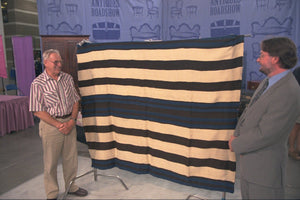























 Beautiful Rainbow of the Navajo. At the center of the Navajo world is their shelter, the
Beautiful Rainbow of the Navajo. At the center of the Navajo world is their shelter, the



 |
|



 Ralph Lauren graces the cover of Architectural Digest and House Beautiful, and shows the whimsical way he uses Navajo weavings to grace and embrace his home, using them as rugs on the floor, wall hangings, and across the back of a couch or chair.
Ralph Lauren graces the cover of Architectural Digest and House Beautiful, and shows the whimsical way he uses Navajo weavings to grace and embrace his home, using them as rugs on the floor, wall hangings, and across the back of a couch or chair. "People are interested in the rugs' decorative qualities, aesthetic value and emotional connection to the life and traditions of a distinct and fascinating culture" says David Roche, Sotheby's specialist in American Indian Art (now Director of the Heard Museum Phoenix Arizona), "There's an excitement to these textiles and a universal quality."
"People are interested in the rugs' decorative qualities, aesthetic value and emotional connection to the life and traditions of a distinct and fascinating culture" says David Roche, Sotheby's specialist in American Indian Art (now Director of the Heard Museum Phoenix Arizona), "There's an excitement to these textiles and a universal quality." One of the most important things to consider when designing with Southwest area rugs is that different rug designs look wonderful when mixed together. With their bold, geometric designs, you might first assume that Southwest area rugs would "clash" with one another. Instead, Navajo rugs and weavings look warm and beautiful when used in multiples.
One of the most important things to consider when designing with Southwest area rugs is that different rug designs look wonderful when mixed together. With their bold, geometric designs, you might first assume that Southwest area rugs would "clash" with one another. Instead, Navajo rugs and weavings look warm and beautiful when used in multiples.


















